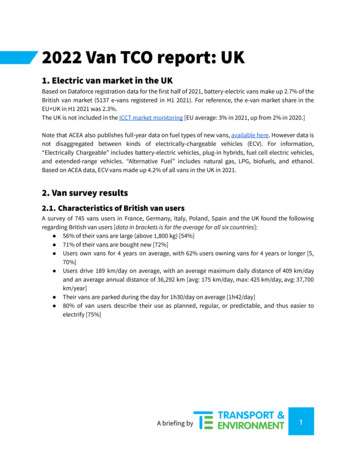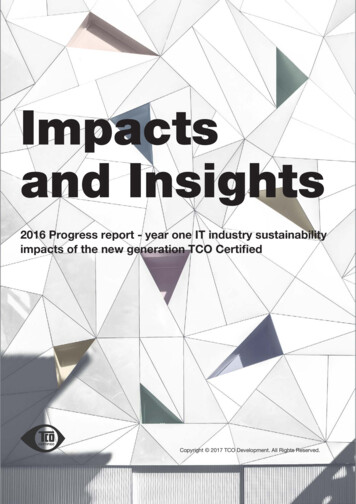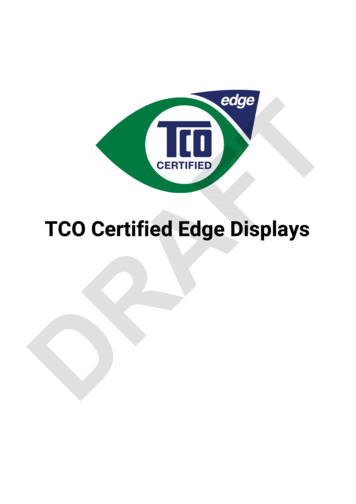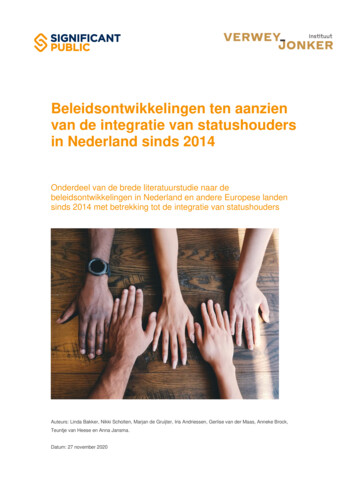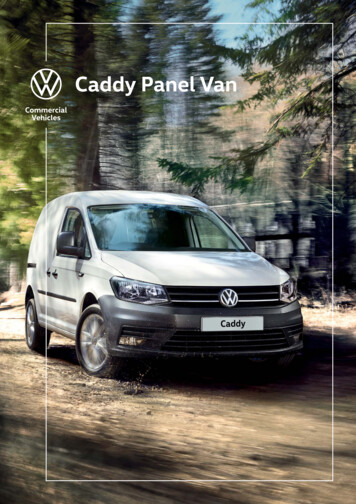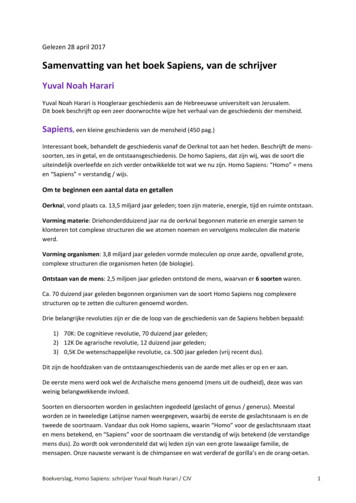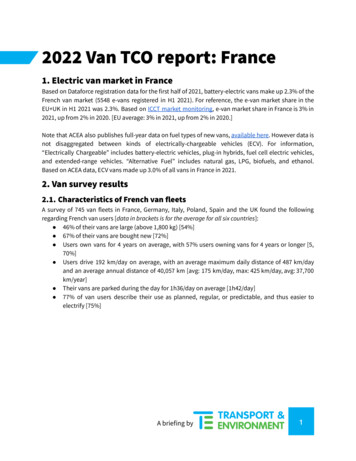
Transcription
2022 Van TCO report: France1. Electric van market in FranceBased on Dataforce registration data for the first half of 2021, battery-electric vans make up 2.3% of theFrench van market (5548 e-vans registered in H1 2021). For reference, the e-van market share in theEU UK in H1 2021 was 2.3%. Based on ICCT market monitoring, e-van market share in France is 3% in2021, up from 2% in 2020. [EU average: 3% in 2021, up from 2% in 2020.]Note that ACEA also publishes full-year data on fuel types of new vans, available here. However data isnot disaggregated between kinds of electrically-chargeable vehicles (ECV). For information,“Electrically Chargeable” includes battery-electric vehicles, plug-in hybrids, fuel cell electric vehicles,and extended-range vehicles. “Alternative Fuel” includes natural gas, LPG, biofuels, and ethanol.Based on ACEA data, ECV vans made up 3.0% of all vans in France in 2021.2. Van survey results2.1. Characteristics of French van fleetsA survey of 745 van fleets in France, Germany, Italy, Poland, Spain and the UK found the followingregarding French van users [data in brackets is for the average for all six countries]: 46% of their vans are large (above 1,800 kg) [54%] 67% of their vans are bought new [72%] Users own vans for 4 years on average, with 57% users owning vans for 4 years or longer [5,70%] Users drive 192 km/day on average, with an average maximum daily distance of 487 km/dayand an average annual distance of 40,057 km [avg: 175 km/day, max: 425 km/day, avg: 37,700km/year] Their vans are parked during the day for 1h36/day on average [1h42/day] 77% of van users describe their use as planned, regular, or predictable, and thus easier toelectrify [75%]A briefing by1
2.2. Attitudes towards electric vansFigure 1: e-van adoption in the surveyIn total, 85% of French fleets either already own an e-van, will buy an electric van in 2022, or wouldconsider buying one for their next purchase [compared to 84% for the survey overall]. 67% of Frenchrespondents would consider a hydrogen fuel cell van for their next purchase [compared to 73% for thesurvey overall]. Of all six countries surveyed, this is the lowest share of fleets with a positive attitudetowards fuel cell vans.A briefing by2
2.3. Reasons for/against e-van ownershipThe top three reasons for e-van adoption in France are CO2 savings, improving the companyʼsimage, and a lower TCO [same ranking as in the survey overall].Figure 2: Reasons for e-van adoption in FranceFigure 3: Reasons for e-van adoption in France, Germany, Italy, Poland, Spain, and the UKA briefing by3
The top three reasons against e-van adoption in France are purchase price, lack of range, and lackof offer of e-van models [top 3 in the survey overall: lack of range, purchase price, lack of publiccharging].Figure 4: Reasons against e-van adoption in FranceFigure 5: Reasons against e-van adoption in France, Germany, Italy, Poland, Spain, and the UKA briefing by4
3. Total Cost of OwnershipThe total cost of ownership (TCO) for light and heavy, diesel and electric vans was estimated for severalcategories of end users. The main inputs are the average duration of ownership—5 years for all endusers except short-term rental services (STR)—and the annual mileage. These inputs are based on datafrom all users in the survey, not just French users1. As a result, differences in TCO between countriesare due to differences in diesel and electricity prices, registration charges, purchases subsidies, etc.Table 1: Van user characteristics used in the TCO modelBased on T&E TCO modelling, electric vans are already cheaper to own than diesel in France: For both light and heavy models For all average users (i.e. average ownership years, average mileage) Both with and without subsidies.1This is because there are too few respondents of each user category in each group, so the results wouldnot be reliable statistically speaking.A briefing by5
Figure 6: TCO of electric and diesel vans in France in 2022A briefing by6
Figure 7: Average TCO of electric and diesel vans in all six countries considered in 20224. Impact of higher targetsWhat adopting T&E targets rather than the EC proposal would mean for France [and the EU]: E-vans: 0.7 million e-vans missing on French roads by 2030 [2.4 million] TCO savings: 4.4 billion euros from 2025–2030 [13.1 billion euros] Oil savings: 33 million barrels of diesel saved in 2025–2030 [101] Emissions savings: 4.2 MtCO2 saved in 2030, 13.7 MtCO2 saved in 2025–2030 [2030: 12.8MtCO2, 2025–2030: 42.3 MtCO2]A briefing by7
The figures below show the impact in France and the EU of opting for the EC proposal instead ofthe T&E targets.Figure 8: Cost, emissions, and oil savings in France from adopting T&Eʼs recommended targets insteadof the Commissionʼs proposed targetsA briefing by8
Figure 9: Cost, emissions, and oil savings in the EU from adopting T&Eʼs recommended targets insteadof the Commissionʼs proposed targetsA briefing by9
2022 Van TCO report: France 1. Electric van market in France Based on Dataforce registration data for the first half of 2021, battery-electric vans make up 2.3% of the French van market (5548 e-vans registered in H1 2021). For reference, the e-van market share in the EU UK in H1 2021 was 2.3%.

